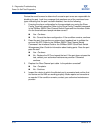
5 – Diagnostics/Troubleshooting
Power-On Self Test Diagnostics
59265-00 A 5-3
A
Power-On Self Test Diagnostics
The switch performs a series of tests as part of its power-up procedure. The
POST diagnostic program performs the following tests:
Checksum tests on the boot firmware in Programmable Read Only Memory
(PROM) and the switch firmware in flash memory
Internal data loopback test on all ports
Access and integrity test on the Application Specific Integrated Circuit
(ASIC)
During the POST, the switch logs any errors encountered. Some POST errors are
critical, others are not. The switch uses the Heartbeat LED and the Logged-In
LED to indicate switch and port status. A critical error disables the switch so that it
will not operate. A non-critical error allows the switch to operate, but disables the
ports that have errors. If two or more ports fail the POST, the entire switch is
disabled. Whether the problem is critical or not, contact your authorized
maintenance provider.
If there are no errors, the Heartbeat LED blinks at a steady rate of once per
second. If a critical error occurs, the Heartbeat LED will show a blink pattern that
indicates an error and the System Fault LED will illuminate. If there are non-critical
errors, the switch disables the failed ports and flashes the associated Logged-In
LEDs. Refer to “Heartbeat LED Blink Patterns” on page 5-3 for more information
about Heartbeat LED blink patterns.
Heartbeat LED Blink Patterns
The Heartbeat LED indicates the operational status of the switch. When the POST
completes with no errors, the Heartbeat LED blinks at steady rate of once per
second. When the switch is in maintenance mode, the Heartbeat LED illuminates
continuously. Refer to “Recovering a Switch Using Maintenance Mode” on
page 5-13 for more information about maintenance mode. All other blink patterns
indicate critical errors. In addition to producing a heartbeat error blink patterns, a
critical error also illuminates the System Fault LED.
The Heartbeat LED shows an error blink pattern for the following conditions:
1 blink – Normal operation
2 blinks – Internal Firmware Failure Blink Pattern
3 blinks – Fatal POST Error Blink Pattern
4 blinks – Configuration File System Error Blink Pattern
5 blinks – Over Temperature Blink Pattern


















